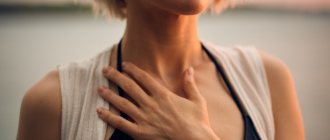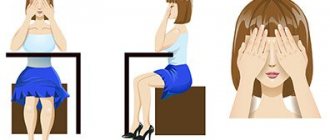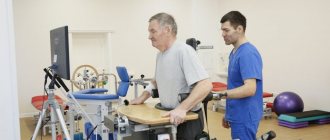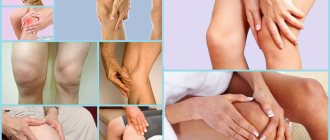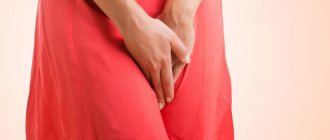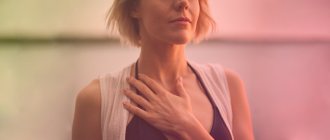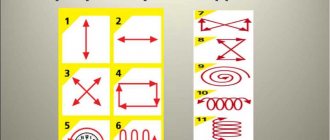Gymnastics Strelnikova - 11 breathing exercises
Breathing exercises according to Strelnikova are based on exercises where inhalations must be taken at the end of the movement, when the chest is compressed. The technique was invented by a mother who was giving a lesson
Strelnikova - breathing exercises - essence and advantages
Once, during another heart attack, Alexandra Strelnikova tried to breathe the way her mother taught her, and the suffocation gradually subsided. From that time on, she began to constantly perform breathing exercises and did not have any health problems. Many famous singers and actors studied with the Strelnikovs, the technique was so impressive that Alexandra filed documents and received a patent for her breathing exercises.
- Strelnikova’s gymnastics activates the entire immune system of the body.
The exercises initially helped restore the voice; later Strelnikova managed to cure her student and follower Mikhail Shchetinin from bronchial asthma. Doctors do not have a clear opinion, but consider the technique to be an effective tool in the treatment of diseases of the respiratory, nervous and cardiovascular systems.
Advantages of the method:
- Combination with cyclic exercises (running, swimming, walking).
- Restoration of diseased organs.
- Disease prevention.
- Positive effect on the entire body.
- Lack of special conditions for classes.
- Increased lung capacity.
- Availability for adults and children.
The method is called paradoxical, because during inhalation the chest is in a compressed state, and not in an expanded state. However, exercise does not cause fatigue, and ventilation increases 5 times. Breathing is performed during movement, the entire energy balance of the human body is restored.
Indications and contraindications of the technique
The technique has a positive effect on all metabolic functions of the body, blood supply to organs and systems, helps restore impaired breathing and strengthen blood vessels.
Recommended for the following indications:
- chronic depression;
- neurotic conditions;
- pregnancy period;
- inflammation of the lungs and bronchi, asthma;
- heart diseases;
- hypertension;
- vegetative-vascular dystonia;
- previous heart attacks and heart rhythm disturbances;
- post-stroke conditions, headaches and epileptic ailments; thyroid disorders and diabetes;
- viral, inflammatory and skin diseases;
- impotence;
- excess weight and smoking.
Gymnastics can be done in parallel with the use of medications; healthy people perform exercises for prevention.
Strelnikova’s gymnastics is contraindicated in the following cases:
- acute conditions with elevated temperature;
- severe pathologies;
- acute thrombophlebitis.
In any situation, without first consulting a doctor, you should not prescribe this complex to yourself.
Breathing exercises by Strelnikova
You need to start training with the initial 3 exercises, twice a day, adding more exercises every day. Initially, increase the rest time between movements to ten seconds, instead of three to five.
- The main feature of the method is a strong and sharp inhalation through the nose.
You need to exhale arbitrarily, preferably through your mouth. The frequency of movements is 100-120 times per minute. Don't spend more than half an hour on a lesson. Strelnikova recommends exercising throughout your life, once a day. Movements 2 to 10 are performed in 12 sets of 8 breaths (12 x 8).
No. 1–Palms
Stand up straight, bend your elbows, palms forward. Take rhythmic breaths through your nose (4 in a row), clenching your palms into fists. Lower your arms and rest for 4 seconds. Exhale freely through your mouth. 24 approaches in any position (lying, standing or sitting). If difficulties arise, increase the rest to 10 seconds.
No. 2 – Shoulder straps
Stand straight, press your hands to your stomach, clenching your fists. Inhaling, you sharply push your fists down, tensing your shoulders. Return your arms back to waist level, relax your shoulders as you exhale. 8 breaths – pause 4 seconds. (12 x 8).
No. 3 – Pump
Stand straight, feet at shoulder distance, arms down along the body. Perform a slight forward bend (rounded back, head down), stretch your hands to the floor without reaching it. Inhale at the same time as you bend over. Then exhale, not straightening up completely. The rate of inclines is from 100 per minute. (12 x 8). If you suffer from head or back injuries, do not bend over too much.
No. 4–Cat
Stand up straight, feet shoulder-distance apart. Squat down a little, turning to the right and taking a sharp breath. Return to your original position. Repeat the movement to the left. The knees are slightly bent, the hands perform grabbing movements. Keep your back straight and turn at the waist. (12 x 8). #5 – Hug your shoulders
In a standing position, bend your elbows and raise them to shoulder level. Take a sharp breath, hugging yourself by the shoulders without crossing your arms. (12 x 8). If it’s hard, perform 4 movements. No. 6–Big pendulum
Stand straight, legs apart, narrower than shoulders. Lean forward, stretching your arms toward the floor and inhaling. Then you come back, wrap your arms around your shoulders and inhale again. (12 x 8). Can be performed while sitting. If you have diseases of the spine, you should not bend backwards.
- Having mastered the first six exercises, proceed to the remaining ones, adding one per day.
#7 – Head turns
Stand straight, legs narrower than shoulders. Turn your head to the right - inhale, to the left - inhale. Exhale between breaths. (12 x 8).
No. 8 – Ears
Stand up straight, legs narrower than shoulders. Tilt your head to the right, touching your ear to your shoulder - inhale, head to the left - inhale. Exhale between breaths (12x8).
No. 9 – Pendulum with head
Stand straight, legs narrower than shoulders. Tilt your head forward, looking at the floor, inhale, back (looking up) – inhale. Exhale between breaths. (12 x 8).
- For head injuries, pathologies of the upper spine and epilepsy, exercises 7-9 can not be performed completely, but inhale sharply.
No. 10 – Rolls
Stand up straight, left leg forward, right leg back. Transfer your body weight to your left leg, bend your right leg and place it on your toe. Squat on your left leg while inhaling strongly. Straighten your leg and shift your weight to your right. Squat on your right leg, inhaling. (12 x 8).
#11 – Steps
Front step. Stand straight, feet at shoulder distance. Raise your left leg, bending it at the knee, to your stomach (the toe stretches down). Squat on your right leg while inhaling noisily. Take the starting position. Repeat with the other leg. 8 times 8 breaths. Rear step. Bend your left leg at the knee, reaching your buttocks with your heel. Squat on your right leg and inhale. Repeat with the other leg. 4 times 8 breaths. For limb injuries, thrombophlebitis, heart disease, raise your legs low, pause for 10 seconds.
Recovery after Covid: video
Perform one or more complexes at a time convenient for you. If possible, it is better to train outdoors or in a well-ventilated area.
- A set of breathing exercises after Covid.
- Exercises for morning exercises or warm-up before training.
- A set of exercises for those who suffer from pneumonia or “corona”.
Don't skip classes and don't rush through them. You should not start training immediately after eating or drinking heavily; before gymnastics, get rid of tight clothes.
Relief from anxiety
Shortness of breath can cause feelings of fear. Some people say they feel anxious when they start to feel short of breath. However, anxiety can make breathing even more difficult.
Breathing exercises from this material can help you relax. You may also want to know other ways to help relieve anxiety. Talk to your doctor about any anxiety you have. He may prescribe anti-anxiety medications such as alprazolam (Xanax®) or lorazepam (Ativan®) to help you.
Our Integrative Medicine Service also offers relaxation programs that may be beneficial for you.
to come back to the beginning
General principles
- You need to exercise regularly and constantly monitor your well-being. It is recommended to give up cigarettes and alcohol: since the rate of blood circulation increases, the body more actively supplies substances to the cells, including nicotine and alcohol.
- During classes, you need to focus as much as possible on the technique and abstract from everything around you.
- You should not exercise immediately after eating; depending on the chosen gymnastics for the lungs, at least an hour should pass after eating.
- The air in the room should be clean to reduce the risk of harmful substances (dust, pollen, viruses, etc.) entering the lungs and blood. To do this, ventilate the room before classes, study with open windows if you live in an environmentally friendly area, or install Tion Breezer 4S supply ventilation with a filter system that removes dust, harmful gases and odors, allergens, viruses and other harmful particles. Thanks to the device, there will always be clean, fresh air in the room, and you can fully concentrate on practicing your breathing technique.
- If discomfort occurs, you must inform your doctor; you cannot continue exercising if you feel weak, have increased shortness of breath, have an increased heart rate, or feel dizzy. In case of ARVI, hypertension, myopia, after severe head injuries, during Covid, breathing exercises can only be prescribed by the attending physician; independent mastery of the practice is prohibited, as it can cause complications.
Adherents of different methods agree on one thing - proper breathing and a healthy lifestyle allow you to stay in good shape longer, cope more easily with stress at work and more easily endure any illness. We told you about the main popular techniques, try different ones under the supervision of a doctor and choose the best one for yourself, and you can take care of fresh, clean air for yourself and your family right now by ordering a breather.
Breathe freely and easily!
Author: Kristina Dulneva
Types of breathing
Different exercises for developing the respiratory system focus on different types:
- top. The diaphragm and abdominal muscles are practically not used, breathing is carried out through the upper chest;
- average The diaphragm lowers slightly and the abdominal muscles contract;
- lower The diaphragm is actively involved, while the abdomen is as relaxed as possible;
- complete Provides the maximum amount of oxygen in the lungs by using three sections of the chest;
- the opposite. Due to the tension of the abdomen and the lowering of the diaphragm, the internal organs are slightly compressed, providing a massage effect;
- with delay. Can be performed after inhalation, exhalation, or after each action.
Standing body bends
Stand facing the wall at a distance of 20-25 cm from it, stretch your arms up, press your palms tightly against the wall. Lean your body forward slightly, opening your chest, and relax your lower back. Gently lean your body to the left, bending your left arm, and with your straightened right arm, describing a semicircle along the wall. Then just as smoothly lean to the right, bending your right arm and describing a semicircle along the wall with your left. This is one repetition. Perform 5-10 repetitions of the exercise.
While doing gymnastics, observe your sensations. If your health allows, you can increase the number of repetitions. If you feel weak, reduce it.
How to breathe while running
If you quickly lose your rhythm while running or start to feel a pain in your side, you may be breathing incorrectly:
- when warming up, do not hold your breath, it should be even and light;
- exhalation should be one and a half to two times longer than inhalation;
- combine upper and lower breathing techniques, then more oxygen will flow and it will be easier for the muscles to work;
- It is better to inhale through the nose and exhale through the mouth. In this case, there is less risk of getting sick, since the air will have time to warm up before it enters the lungs;
- at the end of the run, do not stop, but walk for a couple of minutes, gradually moving to a normal rhythm.
What it is
Breathing exercises are sequential exercises to keep the body in good shape and improve well-being in a number of diseases. Depending on the technique used, it can strengthen bones and ligaments, alleviate the condition after pneumonia and chronic obstructive pulmonary disease, charge with vigor and activity, improve concentration, normalize sleep, etc.
Breathing exercises after coronavirus or another disease associated with changes in lung volume can be prescribed even to bedridden patients. The classes do not require special clothing or equipment; it is enough to spend 15–30 minutes daily to feel an improvement in your overall well-being. When choosing a method for performing breathing exercises, be sure to consult a doctor so as not to cause harm to your health due to contraindications or errors during the implementation process.
